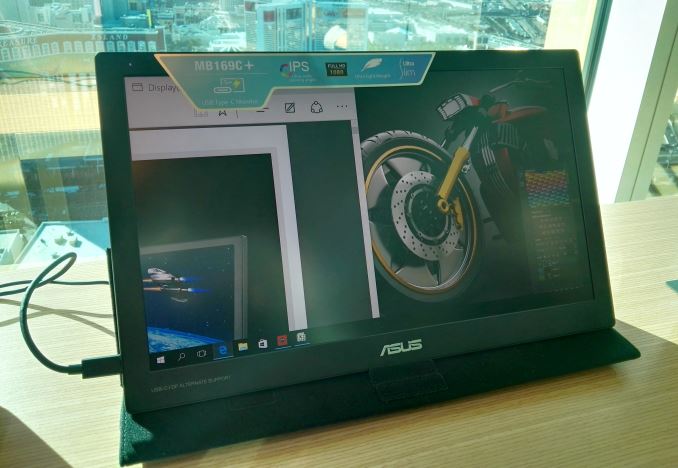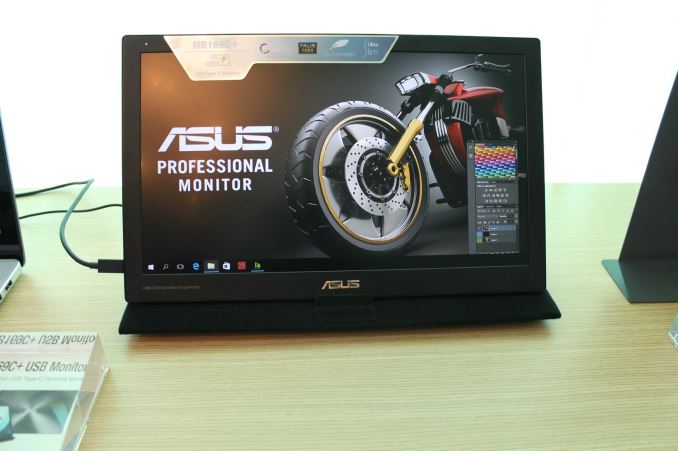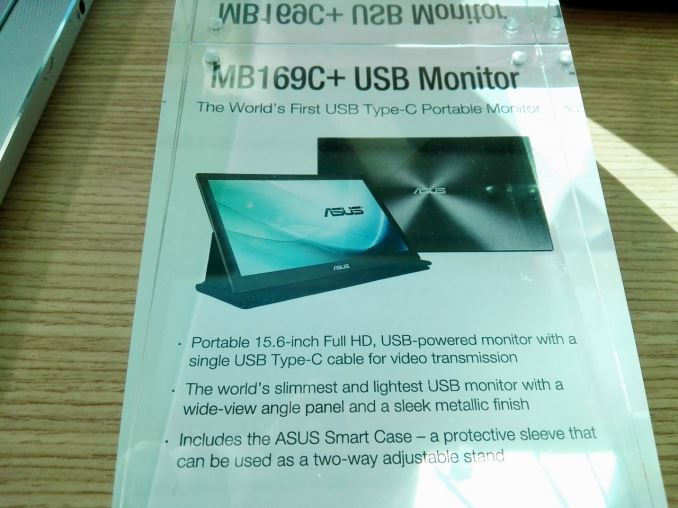ASUS Booth Tour at CES 2016: 10G Switches, External GPU Dock, USB-C Monitor and more
by Ian Cutress on January 19, 2016 9:00 AM ESTA USB Type-C Monitor, the MB169C
USB monitors always feel as if they are just another piece of the puzzle, with not much general interest except for a few business/professional users. The idea is that they can be handy to have around, especially when travelling, and thus need to be light, easy to use, and easy to set up in a different office or hotel room. The other argument is for students, especially those that require multiple screens, without having to order another $150 large 1080p IPS monitor from Newegg in their latest deal, which then becomes an issue when moving from dorm to dorm. The USB monitor market has existed, but never produced anything particularly major. With the advent of tablets however, thin screens of high resolution are now coming down in cost. When it comes to having this sort of screen as a monitor, it only needs the TCON and a connection in, arguably showing that if you can get a 13-inch screen in a laptop under $300, or a 4K panel in a tablet, you could arguably get an extra monitor for a lot less.
So insert ASUS’ latest foray, taking a good quality panel and pairing it with one of the latest technologies. Using Type-C alternate mode, the MB169C+ uses DisplayPort and Type-C for both power and the image, supporting 1920x1080 resolution.
The panel has a separate power switch and a quick volume rocker that relays back to the device being used. This panel is light, thin, and easy to carry in a separate case along with a laptop, despite being a 15.6-inch display.
No word was given on pricing or time to market, though it looked ready to go as we were playing around with it.














50 Comments
View All Comments
DanNeely - Tuesday, January 19, 2016 - link
Is the back of that phone actually made up of a bunch of triangular panels at angles to each other; or does the finish just fake the look?WorldWithoutMadness - Tuesday, January 19, 2016 - link
It is 3D (source http://www.androidcentral.com/hands-asus-zenfone-2...Panzerknacker - Tuesday, January 19, 2016 - link
I just dont understand why did 10G never become mainstream and is it so damn expensive? Back when 100mbit was mainstream the price of 1G was higher but nowhere near $760 for a switch. 1g is now mainstream for a decade or so, what takes it so long? Did we reach the limit of copper networking? I mean, in datacenters there has to be a enormous market for fast networking, I cannot understand why prices are still so high because on a huge market you would expect a lot a competition and fast development of hardware. Or did they completely move to different networking standards in datacenters, like fibre?Reflex - Tuesday, January 19, 2016 - link
Power consumption is very high compared to gigabit, and wireless replaced ethernet for most home and small office use, thus negating economies of scale which normally would drive prices down.Lieuchikaka - Thursday, June 2, 2016 - link
http://mavangvn.vn/ma-vang-dien-thoai/dien-thoai-s...TwistedKestrel - Tuesday, January 19, 2016 - link
It's mostly the ubiquity of 1GbE vs the handful of vendors making 10GbE parts. 1GbE PHYs are cheap as dirt, and 10GbE is two orders of magnitude more expensive... and there aren't that many people that want it yet. Once 1Gb+ throughput on 802.11ac radios becomes more commonplace instead of mostly theoretical, that would be something of a driver for consumer 10GbE.Interesting that a few US ISPs have upcoming or available service in excess of 1Gb, I wonder what kind of connections their equipment would have
DanNeely - Tuesday, January 19, 2016 - link
For consumer service, I'd be really surprised if it was anything but a combined modem/pretend it actually is able to achieve multi-gigabit speeds wifi router.iwod - Tuesday, January 19, 2016 - link
They have new standard NBase-T which provides 2.5Gbps and 5Gbps on Normal CAT 6 Cable. But no idea why no company are getting products out.Alex_M - Wednesday, January 20, 2016 - link
The real benefits for NBase-T will be 2.5/5 Gbps over exisitng Cat5e (not Cat6) upto 100m. It means we don't have to replace all those existing cable runs to benefit from the higher speed. Its fairly new but I hear that the silicon has started sampling....Lieuchikaka - Thursday, June 2, 2016 - link
http://mavangvn.vn/ma-vang-dien-thoai/dien-thoai-s...